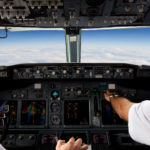After three months of rapid change for aerospace and aviation, FINN editor-in-chief Alan Peaford says greater investment in digital technology will help the industries adapt to future needs
It has been a long time. Leaving Dubai as the airport doors clanged shut behind me at the end of March and into a lockdown in the UK for 13 weeks. Life has changed. Pilot friends and family, proud of their achievements and their careers now freed from employment and tied once again to the surly bonds of earth.
Aircraft that had been their joy as well as their flying office sit idle on closed runways as socially distancing engineers worked to protect these multi-million dollar investments from the dust and the rain.
Factories that had previously delivered advanced manufacturing products for fighter planes and airliner cabins and flight decks were instead cranking out PPE and face masks while most staff went home and waited.
We all wallowed and logged in to Zoom or Team meetings. Brains, having had an enforced break, began planning what comes next. The online meetings took on a new energy. Across the world webinars became interesting as we quenched our thirst for aviation chatter.
A sense of normality is beginning to appear
Today, as much of the world is celebrating a reduction in the spread of the COVID-19 coronavirus and a sense of normality begins to appear, the aerospace industry, like a dazed boxer, is pulling itself up off the canvas. It is looking for help – Governments are being urged to step in with a clear message that aviation is an economic driver for without it, national economies will slump – and revival is reliant on the twin pillars of safety and confidence.
How we share ideas has also changed. Previously, the core of our aerospace world’s exchanges had been those air shows, and conferences, exhibitions and seminars. That chance to hear the big idea, to see the latest innovation and to share thoughts and meet new contacts to buy, to sell and to learn.
For the past 72 years Farnborough Airshow has been one of those essential events. This year, like EBACE, AIX, Sun n’Fun and so on, Farnborough was halted by the pandemic, but like the great P T Barnum allegedly said – “The show must go on”
Farnborough Airshow Connect aims to help industry find its feet
Next month, Farnborough Airshow Connect will be a virtual show, aiming to deliver five days of world class content, collaboration, thought leadership and industry insight; connecting the global aerospace industry during a time when we can’t meet in person. And at the heart of it will be the drive to help this industry to its feet.
On FINN we have spent the past three months offering insight and interviews into some of those great ideas… and some old ones too.
Speaking to Andrew O’Connor from SITA this month, it was fascinating to hear just how many of those great developments over the past few years in airports and border control are already there and should form the basis of solutions and confidence raising assurances to get passengers flying, even as we are still reeling from the pandemic.
Biometrics and face recognition are great – but what about when we are compelled to wear masks? Not a problem says O’Connor. A new tweak and the system will read your details .
Materials that self-clean to remove potential viruses; software that will make sure gates alternate so passengers are not queueing together, these are already in place.
Design and technology is playing its part
The world’s largest manufacturer, Boeing, launched its Confident Travel Initiative, to unite with industry to help minimise air travel health risks during the COVID-19 pandemic. It led a push to raise awareness of technologies like the HEPA filters which process cabin air, virtually row by row, and mixes it with fresh air while filtering out any nasties such as coronavirus bugs.
Design is also playing a part. Dassault Systèmes, David Ziegler showed how 3D modelling was tracking cabin issues and airport passenger flows at airports.
These times offer an ideal opportunity for a step change in delivering solutions that could and should improve passenger experience in years to come. The industry IS working to get its act together as aircraft begin being preparations to re-enter service.
Some carriers, such as the Middle East’s Etihad are good examples, The UAE’s flag carrier has gone out of its way to show how the airline is preparing to ensure safety and comfort combines while the company’s MRO team has also turned to the camera to show how the aircraft are spruced up and made safe.
Will this work? Has enough been done? How can airlines encourage passengers to fly again? Even the optimists are not expecting a bounce back until summer 2021 – while the pessimists see 2022 or 2023 as more likely.
Long recovery spells bad news for supply chain
And this spells bad news for the whole supply chain.
Several airline CEOs that I have spoken to over the past month have put their fleet ambitions on ice. Qatar Airways chief, Akbar Al Baker is pushing back on deliveries of both Airbus and Boeing orders. “We will not be bullied to accept aeroplanes that we do not have any need for during the pandemic – nobody expected something like this to happen,” he said.
The OEMs are witnessing leasing companies cutting back their orders, and airlines returning older aircraft without replacements, The 737 Max, still going through its recertification and safety testing, is also less in the minds of the carriers.
Airlines that might have been pushing for the A320/321 neos or 737 Max will see lower fuel prices as a reason for hanging on to cash and utilising classic aircraft instead.
This spells a warning for companies like Rolls-Royce, who are losing up to 12,000 staff. Without new aircraft coming along the production line, what need is there for new engines?And what about all those pilots, cabin crew, engineers and technicians? But, on the counter side, aviation and aerospace are resilient industries.
Aviation and aerospace are cyclical industries
They are also cyclical industries– but the companies are frighteningly short-termist in their planning. There are many analysts who still predict, that like global finance crash, SARS , 9/11, the return to 2019 numbers will find airlines unprepared for the demand and the human capital will once again be in short supply.
But the world will be different and the industry will be different. In the three years that FINN has been going, digitalisation has been high on the agenda.
One of the after-effects of the pandemic is likely to be a greater investment in the flexibility, adaptability and automation offered by digital transformation
Digitisation will help industry adapt
SITA’s Sébastien Fabre said: “The industry will need to be able to adapt to a new – and changeable – operating environment; one that requires operators to keep passengers feeling safe and reassured, keep flights to time, and meet sustainability targets – all on a tightened budget. Digitalisation is vital here.”
Farnborough Airshow Connect will be focusing on this and on the career opportunities as it brings the flavour of the ‘Farnborough Friday’ which at the ‘live events’ opened the doors of the show to young people to showcase the opportunity that exists in this industry.
Earlier this year, FINN interviewed Mark Goldsack, director of the Department for International Trade Defence and Security Organisation (DIT DSO) about the opportunity Farnborough Friday provides for the next generation.
Although the event will be held online this year, its key message remains the same: the potential of digitalisation and advanced manufacturing technologies that match the ambition of tomorrow’s engineers, pilots and managers. From astronauts to pilots, manufacturers to marketeers the message will be one of potential futures, not history.
As an industry we should be involved in this initiative for a regeneration and a new generation and once again head for the skies.

